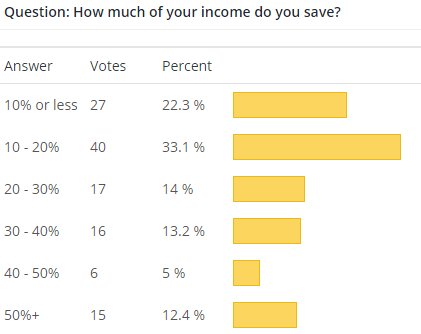Consultants should use surveys more often
They are cost-effective, seemingly impartial, easy to use, and provide data in the “touchy and feel-y” areas where data might be hard to find, collect, or quantify. Bain, PWC, BCG, Deloitte all use surveys; see the links at the bottom of the post. Even on this website, readers reply to surveys to give me a sense of who they are, what they read and what they like here.
Marketers have known this for ages
A well-crafted survey can be a cost effective and ingenious way to gather customer insights. Instead of guessing what consumers want, ask them. Instead of asking them one at a time, send out a survey. With the advent of free tools like survey monkey, and even real-time tools on Skype for business, surveys are ubiquitous and rightly so – they are super useful tools.
As an example of a survey from this website, 121 readers told me anonymously how much of their income they saved. 55% of you (67 people) saved 20% or less, while the there were 12% of you (15 people) saved more than 50% of your income. Bravo.

Surveys create data
I have written before that data is a consultant’s friend because it is apolitical and helps you to test your theories. Surveys can create data where there was none before. A few examples from my past:
- Testing customers’ preference on financial services
- Determining customers’ preference on software features
- Soliciting feedback on presentation materials
- Gauging interest on the venue for a Christmas party
So what makes a good survey?
There are dozens of books, and courses on this topic. Even survey monkey has some tips here. It’s a science and art, but here is my back-of-the-envelope thoughts at 1130pm on a Tuesday night:
Remember the objective: What is critical?
- Clarify the research objective. What are you trying to discover, and do the questions / choices support that? If you are unclear on the problem statement, you will be lost and waste everyone’s time.
- Think it through. Assuming you get the answer, what action will you take?
- Segment and target your audience. Make sure you are getting answers from the right people. Mass-marketing is dead. Which tribe are you trying to target?
- Get personal with limits. If you want to segment you audience, you likely need some information about gender, age, affiliation, geography, income-level etc.
Organize the survey logically
- Put difficult questions in the middle. Put easy questions at the beginning (warm them up), and at the end (when they might start getting bored, anxious). Sara P (in comments) observes: ” think of it like a ‘difficult conversation’ with a stranger, you don’t go in and ask the difficult questions first, you build up to it slowly“
- Make it easy for the respondent to answer (things they know and remember)
- Ask the right type of question. What type of analysis do you want to do (e.g., table, graphic, cross-tab with other questions)? Does the question type do the job? If you want %, definitely don’t ask open-ended questions.
Write simply
- Use short questions with simple words. No acronyms.
- Take out bias from your questions. Don’t lead the witness to the answer you want – that is a cheap shot, unprofessional, and sloppy work.
- Ask 1 question at a time; don’t ask 2-in-1 questions.
- Make choices clear. The choices should be Mutually-exclusives, and collectively exhaustive. Remove ambiguity.
- Include “not applicable ” as a choice.
- Remember the 4 writing persona: madman, architect, carpenter, and judge. Spend the time to architect the order of the questions, carpenter the wording / choices well, and be a harsh judge and edit mercilessly. Rewrite until it’s good.
Think like a marketer
Get a good response rate.
- Call to action. Send the email with a clear title and request.
- Provide an incentive. Sometimes this is a gift card, sometimes a prize, sometimes just sharing the results of the survey.
- Respect privacy of the respondents (and tell them your privacy policy).
- Split test; A/B test. Pretest with 2-3 different email subject lines to see which one has a higher click through rate; then choose the best one for the big survey
Be realistic
- Respect the readers’ time. Don’t ask unnecessary questions. Time the survey to see how long it takes. If your survey is 10+ minutes, you are in trouble.
- Pretest the survey on your friends and colleagues. Don’t embarrass yourself with a bad survey sent to thousands of people.
- People who take surveys are not your average person. If it is by email, they are computer-literate, agreeable, and open to experiences. Arguably, they also have lower opportunity cost of time; they can “afford” the time to do the survey.
Get started
The more surveys you put into the field, the more experienced and fun it will be. Qualitrics is an industrial pro-tool, but why not sign up with Surveymonkey for free? They limit you to 10 questions, but honestly, it’s a great and easy experience.
Readers – what other good survey advice do you have?
- Conrad (in comments) brings up the good point, “Make sure to use an even number of answer choices, to avoid the tendency to ‘straddle the middle’”
